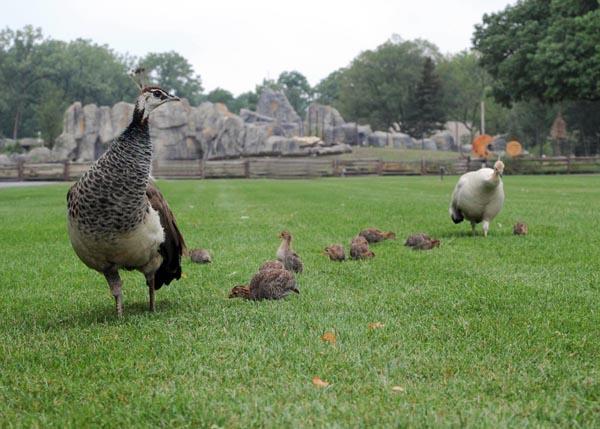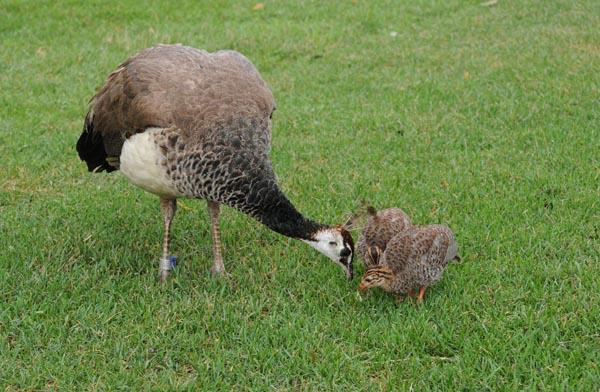
Baby Birds Get Moms of a Different Species

When it comes to raising their young, birds are known to be good and attentive parents. Raising the young of other birds is more questionable, but two Indian peahens at Brookfield Zoo have been doing a commendable job of keeping an eye on and providing some street smarts to some chicks of another species.
Two clutches of Guineafowl chicks that were incubated by Feta and Blue, two of the zoo's Indian peahens, hatched on July 7 and July 14 and are now being raised by the two peahens. Feta and Blue have been caring for the broods, even though the chicks look, act, and sound nothing like them. Their roles have been simple: help the chicks avoid common zoo quandaries such as pedestrians, Motor Safari trams, and predators like the occasional overhead hawk. This is important since both species have free range of the zoo grounds 24/7.
Zoogoers may not notice anything unusual between the moms and chicks, but there are definitely differences and several barriers that they needed to overcome, including language and behaviors, said Tim Snyder, curator of birds for the Chicago Zoological Society, which manages Brookfield Zoo. The first two weeks were a little precarious because the chicks needed to learn what the peahens' vocalization meant and adapt to different behaviors that are not instinctual to them.
For instance, Guineafowl chicks naturally scatter and hide when frightened or threatened, while peachicks run toward their mother. Additionally, Guineafowl moms and chicks move as a group and help care for each others' young , which is the opposite of independent peafowl. Another difference between the two species is the length of time the juvenile birds stay close to Mom. Probably much to Feta and Blue's dismay, the Guineafowl chicks will be tagging along with them for about a year until the next breeding season, which will be in the spring. In the wild, Guineafowl tend to stay together as a flock, including the males, while peafowl juveniles tend to become independent of Mom much sooner.
The practice of switching eggs is not as unusual as it may seem. Other zoos have had success with chickens incubating pheasant eggs, and the method has been tried with cranes, many of which are endangered in the wild.
This is Feta's second time and Blue's first of being successful surrogate moms to Guineafowl chicks at Brookfield Zoo. Although they have free range of the entire park, the family groups can generally be found roaming near The Swamp, Tropic World, or the Formal Pool.

In the wild, Guineafowl are found throughout western, northeastern, and southern Africa in open areas, including forest edges, savannahs, scrublands, and cultivated areas. Indian peafowl, also known as blue peafowl, are the national bird of India and are protected in that country. The species prefers the open forests of India, Pakistan, and Sri Lanka.
Sign up for the Live Science daily newsletter now
Get the world’s most fascinating discoveries delivered straight to your inbox.
The Chicago Zoological Society, which manages Brookfield Zoo, inspires conservation leadership by connecting people with wildlife and nature. Open every day of the year, Brookfield Zoo is located off First Avenue between the Stevenson (I-55) and Eisenhower (I-290) expressways and is also accessible via the Tri-State Tollway (I-294), Metra commuter line, CTA, and PACE bus service. For more information, go to www.CZS.org.










